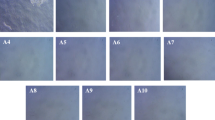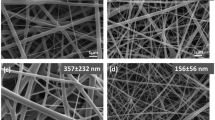Abstract
Electrospun nanofibers offer unique qualities, including a high surface-to-volume ratio, surface modification, and conversion to a fine mesh mat or membrane. Keeping this in mind, chitosan/polyethylene oxide (PEO)/papaya (Pap) nanofibers were developed by electrospinning and characterized by scanning electron microscopy (SEM) and Fourier transform infrared spectroscopy (FTIR). The results from the study infers that, Ch:PEO:Pap (chitosan/PEO)/papaya) nanofibers had a diameter of 78.9 21 nm, resulting in a hydrophobic material with a high contact angle value. FTIR analysis confirms the existence of hydroxyl and amino groups during the interaction of chitosan/PEO and papaya. The Ch:PEO:Pap nanofiber inhibits bacterial growth in broth and the colony-forming ability of Escherichia coli (E. coli) and Staphylococcus aureus (S. aureus) strains. Furthermore, MDA-MB-231 breast cancer cells were found to be cytotoxic upon treatment with Ch:PEO:Pap nanofibers with an inhibitory half-maximum concentration of 60.37 ± 2.6 µg/mL. As indicated by fluorescence microscopy, Ch:PEO:Pap nanofibers stimulate apoptotic cell death by damaging the nuclear membrane. To summarize, the as-prepared Ch:PEO:Pap nanofiber can be a remarkable nanomaterial with an acceptable size that induces antibacterial and anticancer activity.









Similar content being viewed by others
References
Aghebati-Maleki A, Dolati S, Ahmadi M et al (2020) Nanoparticles and cancer therapy: perspectives for application of nanoparticles in the treatment of cancers. J Cell Physiol 235:1962–1972. https://doi.org/10.1002/jcp.29126
Akturk O, Kismet K, Yasti AC et al (2016) Collagen/gold nanoparticle nanocomposites: a potential skin wound healing biomaterial. J Biomater Appl 31:283–301. https://doi.org/10.1177/0885328216644536
Arkoun M, Daigle F, Heuzey M-C, Ajji A (2017) Antibacterial electrospun chitosan-based nanofibers: a bacterial membrane perforator. Food Sci Nutr 5:865–874. https://doi.org/10.1002/fsn3.468
Arockia John Paul J, Karunai Selvi B, Karmegam N (2015) Biosynthesis of silver nanoparticles from Premna serratifolia L. leaf and its anticancer activity in CCl4-induced hepato-cancerous Swiss albino mice. Appl Nanosci 5:937–944. https://doi.org/10.1007/s13204-014-0397-z
Bezir NÇ, Bozkurt B, Evcin A et al (2019) Enhanced antibacterial activity of silver-doped chitosan nanofibers, vol 2178. AIP Publishing, Bodrum, p 030003. https://doi.org/10.1063/1.5135401
Bray F, Ferlay J, Soerjomataram I et al (2018) Global cancer statistics 2018: GLOBOCAN estimates of incidence and mortality worldwide for 36 cancers in 185 countries. Cancer J Clin 68:394–424. https://doi.org/10.3322/caac.21492
Chokradjaroen C, Theeramunkong S, Yui H et al (2018) Cytotoxicity against cancer cells of chitosan oligosaccharides prepared from chitosan powder degraded by electrical discharge plasma. Carbohyd Polym 201:20–30. https://doi.org/10.1016/j.carbpol.2018.08.037
Croisier F, Jérôme C (2013) Chitosan-based biomaterials for tissue engineering. Eur Polymer J 49:780–792. https://doi.org/10.1016/j.eurpolymj.2012.12.009
Croisier F, Sibret P, Dupont-Gillain CC et al (2015) Chitosan-coated electrospun nanofibers with antibacterial activity. J Mater Chem B 3:3508–3517. https://doi.org/10.1039/C5TB00158G
Desai K, Kit K, Li J, Zivanovic S (2008) Morphological and surface properties of electrospun chitosan nanofibers. Biomacromol 9:1000–1006. https://doi.org/10.1021/bm701017z
Divya K, Jisha MS (2018) Chitosan nanoparticles preparation and applications. Environ Chem Lett 16:101–112. https://doi.org/10.1007/s10311-017-0670-y
Djokic J, Kojovic A, Stojanovic D et al (2012) Processing and nanomechanical properties of chitosan/polyethylene oxide blend films. J Serb Chem Soc 77:1723–1733. https://doi.org/10.2298/JSC121121139D
Ercisli MF, Kahrizi D, Aziziaram Z (2021) Environmental factors affecting the risk of breast cancer and the modulating role of vitamin D on this malignancy. Cent Asian J Environ Sci Technol Innov. https://doi.org/10.22034/CAJESTI.2021.04.04
Fu S, Xia J, Wu J (2016) Functional chitosan nanoparticles in cancer treatment. J Biomed Nanotechnol 12:1585–1603. https://doi.org/10.1166/jbn.2016.2228
Garg U, Chauhan S, Nagaich U, Jain N (2019) Current advances in chitosan nanoparticles based drug delivery and targeting. Adv Pharm Bull 9:195–204. https://doi.org/10.15171/apb.2019.023
Gopu M, Kumar P, Selvankumar T et al (2020) Green biomimetic silver nanoparticles utilizing the red algae Amphiroa rigida and its potent antibacterial, cytotoxicity and larvicidal efficiency. Bioprocess Biosyst Eng. https://doi.org/10.1007/s00449-020-02426-1
Heikkilä P, Taipale A, Lehtimäki M, Harlin A (2008) Electrospinning of polyamides with different chain compositions for filtration application. Polym Eng Sci 48:1168–1176. https://doi.org/10.1002/pen.21070
Hietala M, Varrio K, Berglund L et al (2018) Potential of municipal solid waste paper as raw material for production of cellulose nanofibres. Waste Manage 80:319–326. https://doi.org/10.1016/j.wasman.2018.09.033
Huesca-Urióstegui K, García-Valderrama EJ, Gutierrez-Uribe JA et al (2022) Nanofiber systems as herbal bioactive compounds carriers: current applications in healthcare. Pharmaceutics 14:191. https://doi.org/10.3390/pharmaceutics14010191
Kailasa S, Reddy MSB, Maurya MR et al (2021) Electrospun nanofibers: materials, synthesis parameters, and their role in sensing applications. Macromol Mater Eng 306:2100410. https://doi.org/10.1002/mame.202100410
Kalani MM, Nourmohammadi J, Negahdari B et al (2019) Electrospun core-sheath poly(vinyl alcohol)/silk fibroin nanofibers with Rosuvastatin release functionality for enhancing osteogenesis of human adipose-derived stem cells. Mater Sci Eng, C 99:129–139. https://doi.org/10.1016/j.msec.2019.01.100
Kumar P, Senthamilselvi S, Govindaraju M, Sankar R (2014) Unraveling the caspase-mediated mechanism for phloroglucinol-encapsulated starch biopolymer against the breast cancer cell line MDA-MB-231. RSC Adv 4:46157–46163. https://doi.org/10.1039/C4RA06664B
Lepoittevin B, Elzein T, Dragoe D et al (2019) Hydrophobization of chitosan films by surface grafting with fluorinated polymer brushes. Carbohyd Polym 205:437–446. https://doi.org/10.1016/j.carbpol.2018.10.044
Liu Q, Ouyang W-C, Zhou X-H et al (2021) Antibacterial activity and drug loading of moxifloxacin-loaded poly(vinyl alcohol)/chitosan electrospun nanofibers. Front Mater 8:643428. https://doi.org/10.3389/fmats.2021.643428
Mercante LA, Scagion VP, Migliorini FL et al (2017) Electrospinning-based (bio)sensors for food and agricultural applications: a review. TrAC, Trends Anal Chem 91:91–103. https://doi.org/10.1016/j.trac.2017.04.004
Mokhena TC, Jacobs V, Luyt AS (2015) A review on electrospun bio-based polymers for water treatment. Express Polym Lett 9:839–880. https://doi.org/10.3144/expresspolymlett.2015.79
Mosmann T (1983) Rapid colorimetric assay for cellular growth and survival: application to proliferation and cytotoxicity assays. J Immunol Methods 65:55–63. https://doi.org/10.1016/0022-1759(83)90303-4
Parhi R (2017) Cross-linked hydrogel for pharmaceutical applications: a review. Adv Pharm Bull 7:515–530. https://doi.org/10.15171/apb.2017.064
Patel P, Nadar VM, Umapathy D et al (2021a) Doxorubicin-conjugated platinum theranostic nanoparticles induce apoptosis via inhibition of a cell survival (PI3K/AKT) signaling pathway in human breast cancer cells. ACS Appl Nano Mater 4:198–210. https://doi.org/10.1021/acsanm.0c02521
Patel P, Umapathy D, Manivannan S et al (2021b) A doxorubicin–platinum conjugate system: impacts on PI3K/AKT actuation and apoptosis in breast cancer cells. RSC Adv 11:4818–4828. https://doi.org/10.1039/D0RA06708C
Pedziwiatr-Werbicka E, Horodecka K, Shcharbin D, Bryszewska M (2020) Nanoparticles in combating cancer: opportunities and limitations: a brief review. CMC 28:346–359. https://doi.org/10.2174/0929867327666200130101605
Princely SX, Puja P, Vinita MN et al (2020) Anti-proliferative and anti-migratory effects of flower-like bimetallic (Au@Pt) nanoparticles. Mater Lett 267:127491. https://doi.org/10.1016/j.matlet.2020.127491
Puja P, Vinita NM, Devan U et al (2020) Fluorescence microscopy-based analysis of apoptosis induced by platinum nanoparticles against breast cancer cells. Appl Organomet Chem. https://doi.org/10.1002/aoc.5740
Qi L, Xu Z, Jiang X et al (2004) Preparation and antibacterial activity of chitosan nanoparticles. Carbohyd Res 339:2693–2700. https://doi.org/10.1016/j.carres.2004.09.007
Sadasivam RK, Mohiyuddin S, Packirisamy G (2017) Electrospun polyacrylonitrile (PAN) templated 2D nanofibrous mats: a platform toward practical applications for dye removal and bacterial disinfection. ACS Omega 2:6556–6569. https://doi.org/10.1021/acsomega.7b01101
Shanmuganathan R, Karuppusamy I, Saravanan M et al (2019) Synthesis of silver nanoparticles and their biomedical applications—a comprehensive review. Curr Pharm Des 25:2650–2660. https://doi.org/10.2174/1381612825666190708185506
Shariful MI, Sharif SB, Lee JJL et al (2017) Adsorption of divalent heavy metal ion by mesoporous-high surface area chitosan/poly (ethylene oxide) nanofibrous membrane. Carbohyd Polym 157:57–64. https://doi.org/10.1016/j.carbpol.2016.09.063
Sharma A, Bachheti A, Sharma P et al (2020) Phytochemistry, pharmacological activities, nanoparticle fabrication, commercial products and waste utilization of Carica papaya L.: A comprehensive review. Curr Res Biotechnol 2:145–160. https://doi.org/10.1016/j.crbiot.2020.11.001
Solairaj D, Rameshthangam P, Arunachalam G (2017a) Anticancer activity of silver and copper embedded chitin nanocomposites against human breast cancer (MCF-7) cells. Int J Biol Macromol 105:608–619. https://doi.org/10.1016/j.ijbiomac.2017.07.078
Solairaj D, Rameshthangam P, Muthukumaran P, Wilson J (2017b) Studies on electrochemical glucose sensing, antimicrobial activity and cytotoxicity of fabricated copper nanoparticle immobilized chitin nanostructure. Int J Biol Macromol 101:668–679. https://doi.org/10.1016/j.ijbiomac.2017.03.147
Tolbin AYu, Pushkarev VE, Sedova MV et al (2018) Aggregation of slipped-cofacial phthalocyanine J-type dimers: Spectroscopic and AFM study. Spectrochim Acta Part A Mol Biomol Spectrosc 205:335–340. https://doi.org/10.1016/j.saa.2018.07.052
Varadavenkatesan T, Selvaraj R, Vinayagam R (2020) Green synthesis of silver nanoparticles using thunbergia grandiflora flower extract and its catalytic action in reduction of Congo red dye. Mater Today 23:39–42. https://doi.org/10.1016/j.matpr.2019.05.441
Wang M, Yu D-G, Li X, Williams GR (2020) The development and bio-applications of multifluid electrospinning. Mater Highlights 1:1. https://doi.org/10.2991/mathi.k.200521.001
Wright SL, Kelly FJ (2017) Plastic and human health: a micro issue? Environ Sci Technol 51:6634–6647. https://doi.org/10.1021/acs.est.7b00423
Zhao L-M, Shi L-E, Zhang Z-L et al (2011) Preparation and application of chitosan nanoparticles and nanofibers. Braz J Chem Eng 28:353–362. https://doi.org/10.1590/S0104-66322011000300001
Zivanovic S, Li J, Davidson PM, Kit K (2007) Physical, mechanical, and antibacterial properties of chitosan/PEO blend films. Biomacromol 8:1505–1510. https://doi.org/10.1021/bm061140p
Acknowledgements
The corresponding author P. Rameshthangam (PRT) greatly acknowledges and thank the Indian National Science Academy (INSA), New Delhi, India, for the award of INSA Visiting Scientist and also for funding (INSA/SP/VSP-14/2018-19/01 June 2018). The corresponding author also thanks, Professor P. Gopinath, Head, Centre of Nanotechnology, Department of Biosciences and Bioengineering, Indian Institute of Technology Roorkee, Uttarakhand, India, for allowing me to carry out the research work. All authors sincerely thank the support of the RUSA—Phase 2.0 grant (F. 24-51/2014 U) to Alagappa University, Karaikudi.
Author information
Authors and Affiliations
Corresponding author
Additional information
Publisher's Note
Springer Nature remains neutral with regard to jurisdictional claims in published maps and institutional affiliations.
Rights and permissions
Springer Nature or its licensor holds exclusive rights to this article under a publishing agreement with the author(s) or other rightsholder(s); author self-archiving of the accepted manuscript version of this article is solely governed by the terms of such publishing agreement and applicable law.
About this article
Cite this article
Rameshthangam, P., Kumar, P., Muthulakshmi, M. et al. Anti-cancer and bactericidal activity of electrospun chitosan/poly(ethylene oxide)/papaya nanofibres. Appl Nanosci 13, 6105–6113 (2023). https://doi.org/10.1007/s13204-022-02669-2
Received:
Accepted:
Published:
Issue Date:
DOI: https://doi.org/10.1007/s13204-022-02669-2




